What I learnt from the ANU Rare Earth Conference (REECON)
This is a busy time of year for me. There is the Australian reporting season, the US third quarter reporting season, and the conference season. Last week was especially hectic for me with the annual IMARC Mines and Money Conference in Sydney, and new kid of the block for mining investors, the ANU Rare Earth Conference, in Canberra. This wire is about the latter.
There were no journalists present and only one fund manager - which was me.
I expect that this will change in future years because it was a landmark conference with a host of very informative talks from miners on the attributes of their deposits, geoscientists on the ongoing research into the Australian rare earth endowment, mineralogy, and likely formation processes, through experts from the highly complex processing and separation industry to commentators on geopolitics, geostrategy, supply chains, and the Australia-China relationship.
The ANU Rare Earth Conference (REECON) brought together about 180 attendees from across the spectrum of listed company activity in Rare Earths, from production, with talks by Lynas Rare Earths (LYC.AX) and Iluka Resources (ILU.AX), through advanced developers, such as Hasting Technology Metals (HAS.AX), Arafura (ARU.AX), Northern Minerals (NTU.AX), Peak Resources (PEK.AX), and Australian Strategic Materials (ASM.AX) to explorers, such as the enervating Dreadnought Resources (DRE.AX), and a wide array of clay-hosted rare earth juniors, with much to share on their learnings in a rapidly developing field.
For me, as an investor, there were three key takeaways:
- The variety and scale of Australian REE mineralization is much larger than I expected
- Mining firms at all stages from exploration to production are innovating rapidly
- Australian geoscience is world class in this area and actively learning from real projects
There remain many issues that need to be solved to build this industry:
- Offtake agreements remain a challenge with China remaining the dominant buyer
- Debt finance from government has stepped up but equity finance is still an obstacle
- Rare earth deposits are complex and skills in mineralogy, petrology and processing are key
While these obstacles are significant, there is tremendous enthusiasm across government, the mining industry, academic geoscience, research laboratories, analytical laboratories, and the geostrategy community to "step up" to the plate and make Australian Rare Earths grow.
In no particular order, I now share my learnings for the benefit of folks who were not there.
Government remains serious with ongoing critical minerals support
The establishment of the Critical Minerals Office (CMO), under the former federal government, marked a welcome step-up in policy attention to the challenges of growing Australian activity to meet the challenge of the Energy Transition. It was very welcome to see that such support has remained bipartisan under the new Resource Minister, The Hon Madeleine King MP.
Opening remarks to a specialist conference are rarely this high-level or as on point.
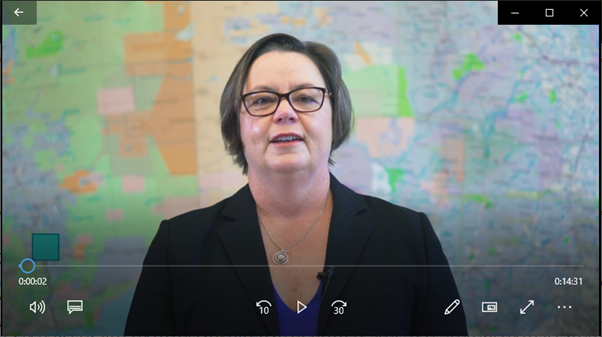
You can view the video here.
Policy matters in this area due to the extraordinary level of international cooperation that is required in building an integrated rare earth supply chain to supply those metals needed to power decarbonization. Governments in Australia, the USA, the European Union, Japan, the United Kingdom, India, and South Korea are increasingly engaged in collaborative policy development. China gets it also, which is why their industry is expanding overseas.
China looms large in global rare earths and that has security implications
Professor Rory Medcalf, Head of the National Security College, ANU, gave one of two engaging keynote speeches, his focus being the China Challenge, and understanding the importance of critical minerals, in general, and rare earths in particular, to national security questions.
This theme recurred in active discussion throughout the conference with two basic viewpoints.
China aware but defence agnostic: the view that defence markets are small and so will, not, of themselves support the establishment of an integrated ex-China supply chain.
This viewpoint shared the room with the more concerning angle:
Defence is central to national security and so we should be concerned to be over-reliant on a single source for the critical minerals to maintain military strength in defence posture.
Clearly, there are elements of truth to both points of view, and the question was debated on numerous occasions within conference sessions, and over dinner during a panel session that was hosted by Australian Strategic Policy Institute (ASPI) analyst David Uren, who wrote his summary here: Breaking China’s near monopoly on rare earths will be easier said than done.
On that point, all were in furious agreement.
Scaling the global rare earth supply chain will involve many challenges since China has such a strong position, but also because it requires a diverse and complex skillset to attack each part of the necessary supply chain development from the mine through to magnets.
China has changed strategy towards monopsony buying power
The global rare earth industry has been through many upheavals, over several decades. In the very early decades of the twentieth century, rare earth demand was largely filled by mineral sands, and the target products were mischmetal for cigarette lighters and salts of the mildly radioactive metal Thorium, which then had a market for use in gas mantles for lighting.
The advent of the electronic age, post-World War II, grew global demand rapidly across many new applications in electronics, optoelectronics, chemical engineering, nuclear engineering and the then dominant market for phosphors, such as Europium, used in color televisions.
The supply of rare earths soon switched from mineral sands to become dominated by one large mine in the United States, called Mountain Pass, in California. This mine held the top spot until the late 1980s when China managed to crack the code of how to process minerals from their very large Bayan Obo deposit in Inner Mongolia. Thereafter, China moved to dominate production, processing, separation, metallization and magnet manufacture.
The emergence of new energy applications brought rare earths to prominence in the years 2010 to 2011, when a spat between China and Japan over disputed territory, the Senkaku/Diaoyu dispute, led China to embargo exports of rare earths to Japan. This action caused rare earth prices to skyrocket, but it also led to substitution away from rare earths in some markets, and poor profitability in China, due to the existence of an artificially high export price, and a low domestic price.
Ultimately, China relented under a World Trade Organization (WTO) action in 2014 and lifted the embargo. However, the damage to confidence had been done, and nations like Japan reached out for new sources of supply. That culminated in the funding of the Mt Weld mine in Western Australia, as developed by Lynas Rare Earths with funding support from offtake partner Sojitz Corporation and the Government of Japan.
Meanwhile, the Mountain Pass mine in the USA, which was then operated by Molycorp, went bust due to the effect of collapsing rare earth prices, following the lifting of the Chinese embargo. This is important to an understanding of why the present unified policy efforts of countries like Australia, the United States, Japan and South Korea are key to the future.
In the 2010-2011 period, China produced about 97% of global rare earths. Now they produce about 62% of global rare earths, due to growth in new supply from mines outside of China. However, China has not sacrificed advantage in making this move, since they have grown their share of downstream activities in separation, metallization, and magnet manufacture.
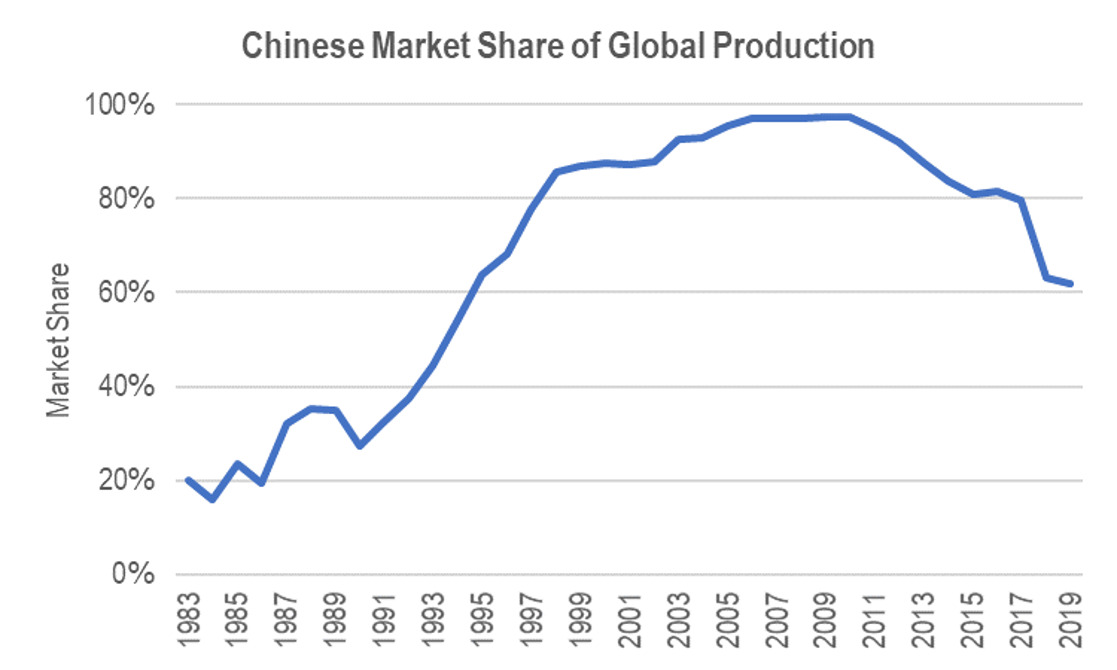
This strategy of moving downstream, while ceding market share upstream, can be just as difficult for ex-China players as the former mining monopoly. The relevant word to describe the new dynamic is monopsony. This means a market with one dominant buyer.
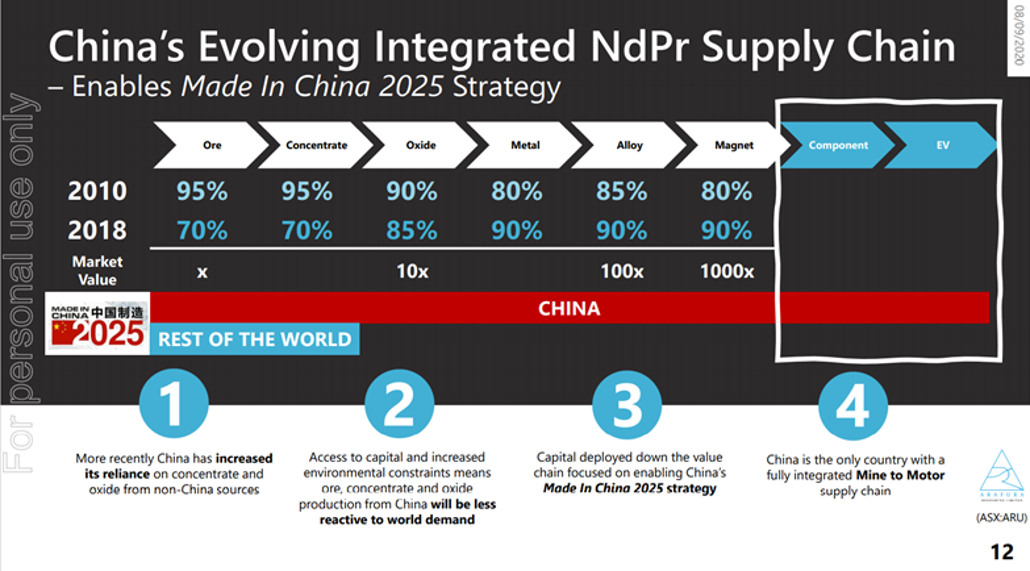
Obviously, these dynamic changes from China are re-shaping global supply chains. One of the more surprising facts is that the United States is now the dominant swing producer of mixed rare earth concentrates supplied into China.
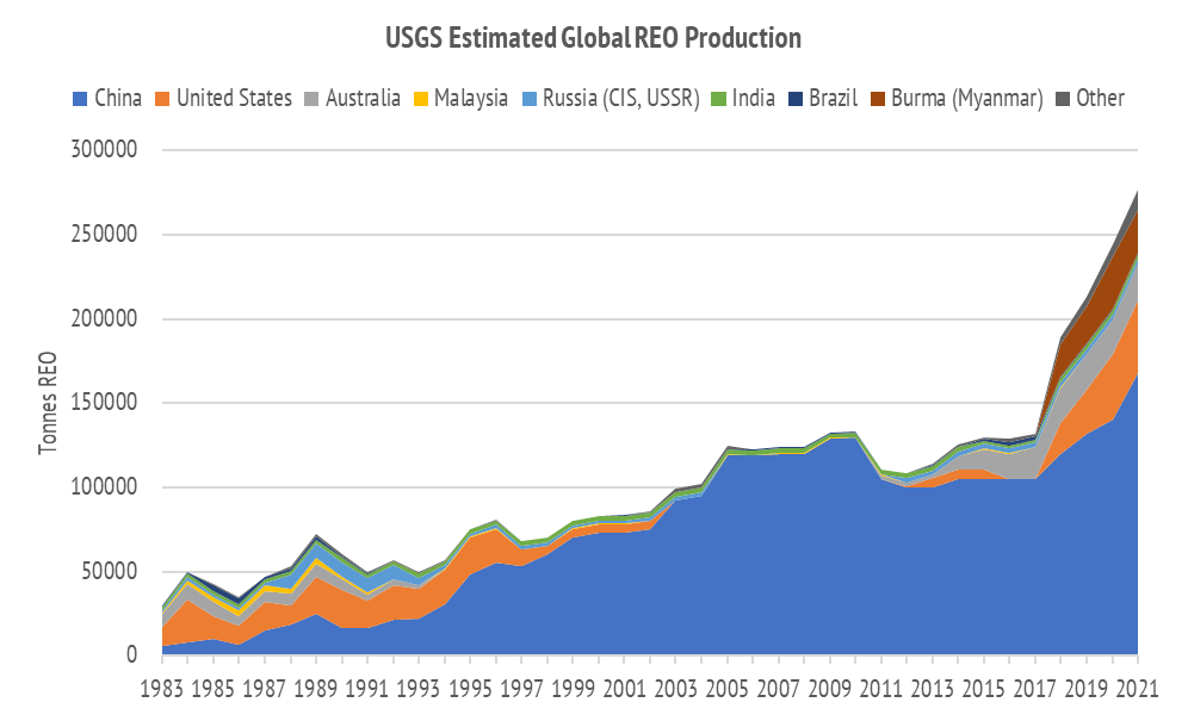
Evidently, the question of what China does will affect this industry. Data from the Chinese Ministry of Natural Resources highlights that their own domestic mining and separation activity is also growing rapidly. This appears to be driven by electric vehicle demand.
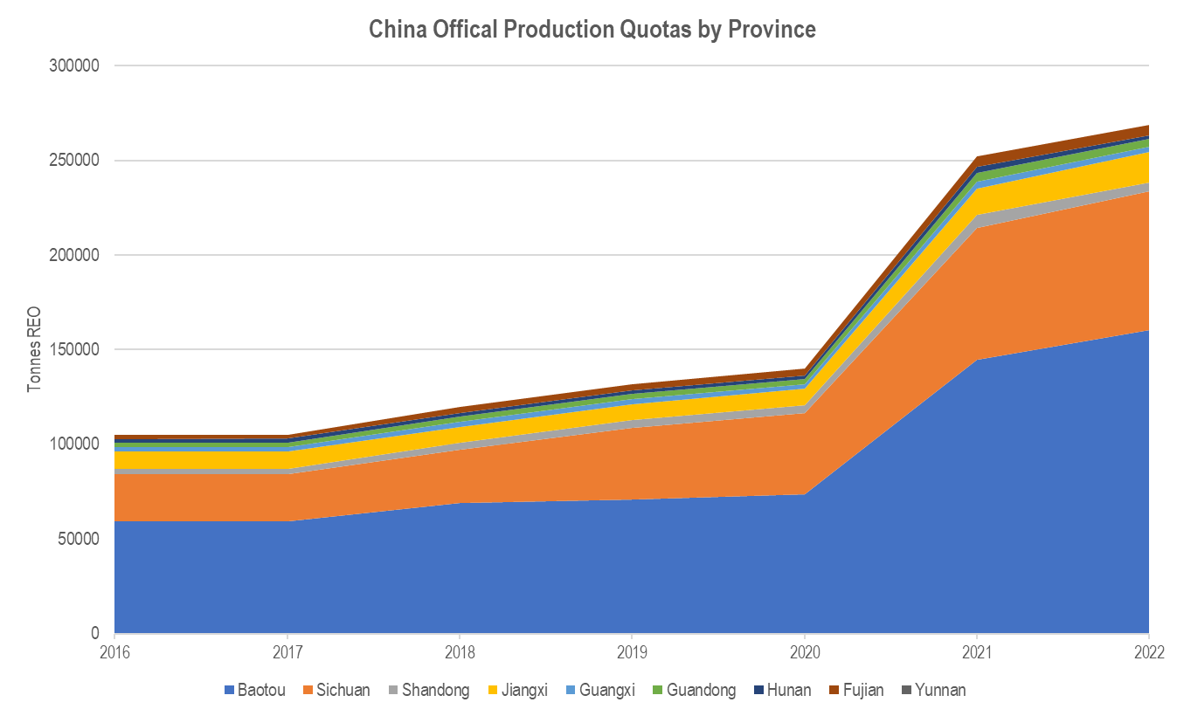
Evidently, miners, explorers, investors, and policy makers will need to keep a close eye on these trends as China is not standing still on their own strategic policy initiatives.
Australian geoscience is stepping up to the rare earth supply challenge
Following the usual conference keynote pre-amble, the conference proper started with an excellent survey by Associate Professor Carl Spandler (University of Adelaide), who leads a young team of collaborators, both at the University of Adelaide, and around the country.
The focus of this talk, and many of the mineral deposit specific talks that followed, was to set an appropriate context for current and future exploration. Individually, and collectively, the Australian Rare Earth community is stepping up for a comprehensive program to understand the major rare earth mineral occurrences, where they are, how they form, and their unique properties, as minerals in place, and what the devil actually got them there.
There were simply too many great talks to summarize in this forum.
They will write about it one day as a transformative moment in putting so many dedicated experts in the one room, from geoscience, mineralogy, petrology and exploration geologists.
You had to be there.
The Carbonatite Crew
Carbonatites are one host mineral type which figures prominently in major commercial rare earth deposits worldwide. We heard talks from Lynas Rare Earths (LYC.AX), RareX (REE.AX), Hastings Technology Metals (HAS.AX) and Dreadnought Resources (DRE.AX), about the very encouraging scope and scale of Australian REE-rich carbonatite deposits. The Gascoyne Region of Western Australia has been a particularly rich hunting ground.
Parallel to the discovery efforts on drill targets, the conference audience was treated to an excellent summary of the possible structural features and mechanisms associated with the formation of carbonatites, especially in Western Australia. This was topped off with the later presentation, by Dr Michael Anenburg, of the ANU, on how to make artificial carbonatites in a piece of a high-pressure laboratory kit good enough to make your own diamonds.
In many ways, it became clear to me that this is a science project with dollars at one end, a bunch of very smart minds at the other end, and an expanding array of drill targets lying smack bang in the middle of some of the most prospective discovery ground on earth.
The investor in me made sure I had wines in the right company over dinner.
The Unconformity Ultras
Since I am not a geologist, I have trouble telling my ultramafic from my felsic floss, or igneous peralkaline whatever it was. It made me feel really good when the conference organizer, the larger-than-life Professor John Mavrogenes, rapped at the end about the importance of having more mineralogists because there were 655 minerals with rare earths. I ducked out before the spelling bee started.
Leastways, those 655 oddly named freaks are the ones that we know about.
Rare earth geoscience is not a field for the tongue tied, or those intimidated by chemical formulae. However, as an investor, I have learned one thing about geoscience. It is all about maps. Just learn to read the maps right.
My solution is simple. I write down whatever the hell kind of rock it is and remember to stick the appropriate color-coded cocktail umbrella in the right map location.
This is easier than it sounds because exploration geologists are always shoving colored maps at you. These maps tell you where the treasure is (supposedly) buried - hence the cocktail umbrella. When they have funny names, you just get a new color cocktail umbrella, and make sure you put the right colored pin in the properly named rock.
This worked for me with unconformity deposits.
Essentially, you have one color on the map sitting atop another color on the map.
It is a lot more complicated than that, because you surely need the right rocks, and they need to have gotten to where they are, sitting side by side in a boundary layer, in the right way.
However, the trick with some of the most interesting ground for hard-rock exploration is the presence of rare earth unconformity deposits across a large expanse of the border land between the Northern Territory and Western Australia. This the Browns Range area, as explored by heavy rare earth play Nothern Minerals (NTU.AX) and also PVW Resources (PVW.AX).
Clays ain't Clays
The now defunct brand of motor oil, Castrol, once ran an advertising campaign declaring that Oils ain't Oils, meaning that some are better than others in interesting ways. Since your 1970s motorist was not much given to talking about oils over dinner, this was effective advertising.
In the middle part of the conference, we all entered the world of Clay hosted Rare Earths.
First, there was Ionic Rare Earths (IXR.AX) at Makuutu in Uganda, and then Australian Rare Earths (AR3.AX) at Koppamurra in the South Australian borderlands area. Then, poof, we now find there are many, too many to mention everybody, and all with some kind of clay that has some kind of rare earth mineralization. Working out who has what and where will take time.
The full list of participants is available at the public conference program.
There are too many to mention here, and I really don't want to for one very good reason:
Clays ain't Clays - that is what (I think) we all learned from the ANU REECON
This is not a pejorative statement, but an acknowledgment that this area is (now) right on the very frontier of what is known, and what is not known, about a lot of things:
- Are they actually Ionic-Adsorption Clay (IAC) deposits?
- Does it matter if they are or not if you can extract them?
- Will anybody let you extract them if you messed up the landscape?
- How could you do it without messing up the landscape?
- Who should you call if you have one and need to know what pH to use?
I could not answer any of these questions, except maybe the last one.
The answer to that question is Bob Ring, from the Australian Nuclear Science and Technology Organization (ANSTO). He gave an excellent talk on the intricacies of processing and solvent extraction for pretty much all known REE mineralization types that have been cracked.
This field is complicated and ANSTO are the unsung heroes of flow-sheet development for rare earth minerals and uranium, with a new line in lithium flow-sheet development.
Pretty much all of the major rare earth development projects have worked with ANSTO at some point. We heard more about this history from Dr Karin Soldenhoff, also from ANSTO. After many years of work in this area, the advice from both experts amounted to this:
Start at the beginning, with what is known to work. If it does not work, then try something new and different. If your first idea does work, then do experiments to improve it. Once you are done with one area, start over to see what you can do with the bits that don't work.
This seemed like sound advice to me.
Don't try and separate everything if that is too complicated and expensive.
Work on economic and safe solutions to do what you can.
I have a feeling that this so-called "met-work" on separation, recovery, and the fine tuning of flowsheets to make them economically viable, will figure very prominently in general, but especially for the new clay-hosted deposits.
Construction of a pilot plant may seem expensive to some investors who are impatient to get on and build the full plant. The lesson from ANSTO is to hasten slowly but be very rigorous to quit chasing rainbows when the impurity levels don't stack up, recoveries are marginal, or the process works but requires more Sulphur than there is in Hades to run the acid plant.
The bottom line is that relatively few of the known rare earth bearing minerals can actually be processed commercially at scale. The primary commercial minerals are Bastnäsite, Monazite, Xenotime, and Ion-Adsorbed Clays (IAC), such as are found in south-eastern China. This was explained with some care by Damien Krebs, who was the Metallurgy Manager at Greenland Minerals (GGG.AX), when that firm developed the flowsheet for Steenstrupine, the mineral that hosts rare earths at Kvanefjeld, in Greenland. While that development was a first, the project went into limbo when the new Greenland Government stopped development.
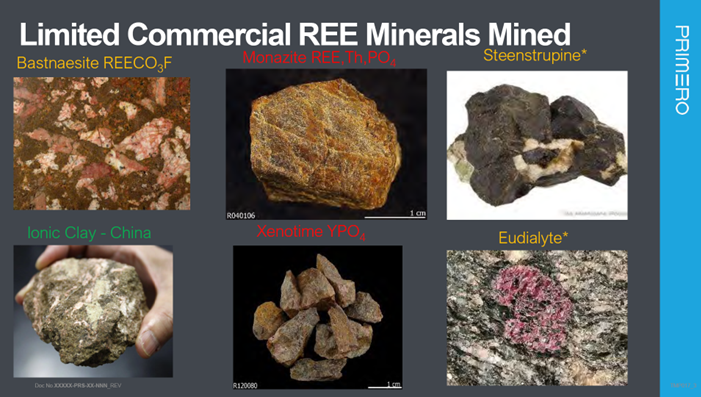
These mineral types vary considerably in their ease of processing. As Damien explained, there is a simple rule of thumb that xenotime and monazite are the most refractory, and difficult to crack, while Bastnäsite and Steenstrupine are easier, and a true Ionic Clay, the easiest of all.
Mineral sands gets its mojo back
Finally, I should mention one rare earth deposit type which has fascinated me as possible low hanging fruit, albeit with some historical baggage. This is the heavy mineral sands deposits that can be rich in both monazite and xenotime minerals.
Up until 1993, Australia dominated the production of mineral sands derive monazite, which was mostly mined at Eneabba in Western Australia. The mineral concentrate was shipped to France, where it was fully processed and separated into component rare earths at a famous plant at La Rochelle. That plant stopped processing material when the available on-site storage for unwanted Thorium and other radionuclides led to a halt on activity.
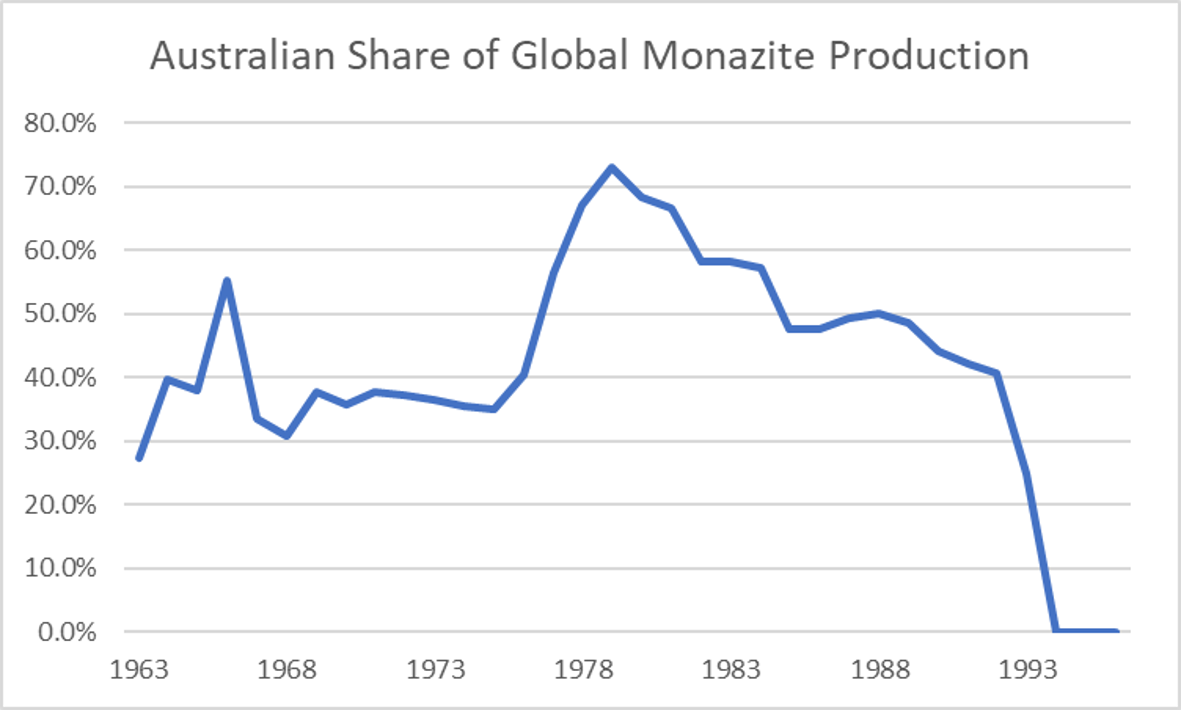
The material that had been mined, but not shipped, at Eneabba, was then stockpiled at an underground facility in Western Australia, in a form that could be later processed.
In one of the keynote talks, Tom O'Leary, CEO of Iluka Resources (ILU.AX) described their thinking on building Australia's first fully integrated rare earths refinery. This will separate and refine the stockpiled heavy and light rare earth feedstock at Eneabba to produce both heavy and light rare earth oxides. The process technology descends from the original La Rochelle plant in France, via the involvement of French firm Carester, whose staff spent many years operating and tuning the La Rochelle plant, first on mineral feedstock, and later recycled material from the European Union program to recover rare earth from waste.
Thie provision of non-recourse loan finance from the Australian Federal Government shows a commitment to help build out further the rare earth supply chain. This will complement the planned Kalgoorlie Rare Earths Processing Facility from Lynas Rare Earths (LYC.AX).
The aim in developing mineral sands processing is that there are many such deposits in Australia, and they are not all of them owned by Iluka. The government funding support followed a commitment to create a shared processing facility that could toll-treat mixed rare earth concentrate from other mines. Recently Northern Minerals and Iluka Resources inked a deal to progress this option for heavy rare earth rich xenotime from Browns Range.
The metallization moon shot
If this were not exciting enough, industry doyen Ian Chalmers, presented on the geology of the Dubbo Toongi polymetallic deposit, once with Alkane, but since spun off to the pure play rare metals firm Australian Strategic Materials (ASM.AX).
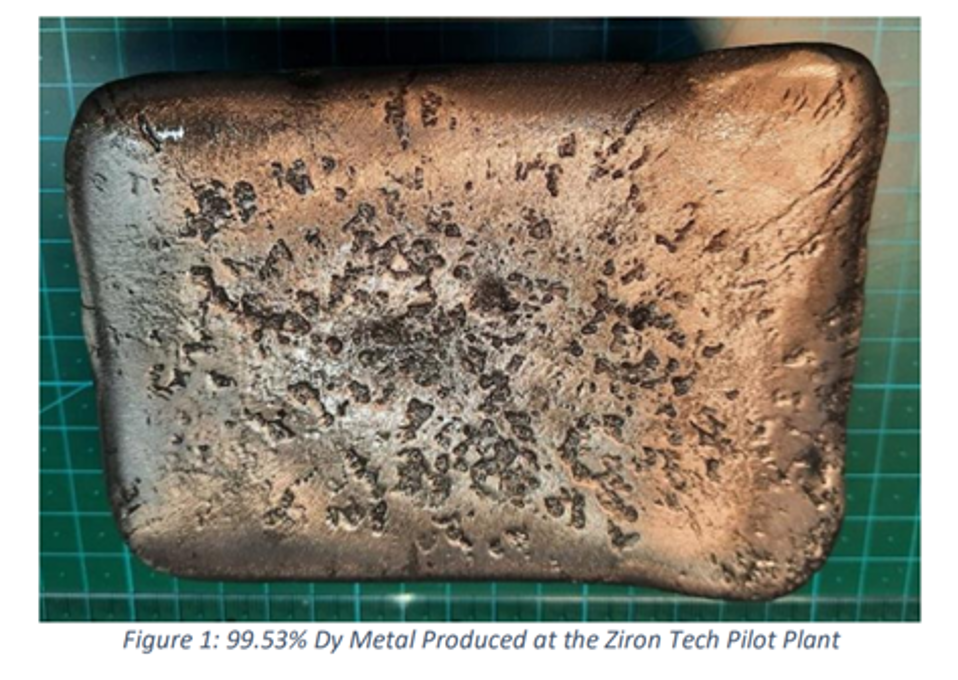
Earlier, I mentioned the word monopsony, and the manner in which China has chosen to consolidate its position in downstream value-added activity. Upwards of 75% of market value for the global rare earth industry is in the magnet supply chain, using the so-called magnet rare earths: Neodymium (Nd); Praseodymium (Pr); Dysprosium (Dy) and Terbium (Tb).
As Ian explained, the economics of the Dubbo Toongi project is improved once the Zirconium and Hafnium metals component is monetized. This can be done through the Zirontech metal refining process that ASM acquired in South Korea.
As the company ASX progress reports demonstrate, ASM has been able to refine pure metal at two nines purity (99%) or better at its pilot plant in South Korea. They have also made some commercial sales of such metal into downstream industrial customers.
This plan struck me as the way forward to defeat Chinese monopsony market power.
ASM has further proving work to do on scaling up their South Korean metals plant and making commercial sales in sufficient quantity to prove up the non-Chinese buyer appetite. There are risks involved in such a strategy, but South Korea is home to numerous automobile firms that need to find their own freedom from China-based supply chain concentration.
Ideally, ASM would first prove up the depth of metal demand using oxide raw material that is bought on market, and then backfill that raw material from their Dubbo Toongi deposit.
This is an audacious and visionary plan, which is why we like it.
The USA gets serious
For some years, I have been personally frustrated to see a great deal of rhetoric coming from the US-based national security community, on the critical importance of rare earths, but not very much visible action to support supply chain growth.
However, at such times, I always remember the saying attributed to Winston Churchill:
You can depend upon the Americans to do the right thing. But only after they have exhausted every other possibility.
The concluding panel session of the conference consisted of a discussion: Geoscience to Geostrategy: Scaling the Global Rare Earth Supply Chain. The contributors were Dr Karin Soldenhoff of ANSTO, Nev Power (former CEO of Fortescue) and Michael Sullivan (US Embassy Economic Advisor). It was a wide-ranging discussion, with several takeaways about the importance of getting moving doing what we can, being alert to how strategy in China could defeat business development if efforts were not integrated, and the important role likely to be played by developing US policy in national security, and the energy transition.
This was a very nuanced discussion, with much audience interaction, but the key point for me was the message that USA does intend to pursue these policy initiatives through to the end.
That end state involves a much more secure supply chain for critical minerals, and not only to combat Chinese dominance, but to properly scale the supply chain for the great exponential challenge ahead. if we are to wean the world off fossil fuels, then all studies demonstrate that critical minerals will prove key to electrification, whether lithium, nickel, cobalt, and graphite in batteries, or rare earths in the high-performance electric motors in electric vehicles.
Generation Critical
In this wire, I covered a lot of ground on a tremendously exciting conference. Since the ANU REECON was new, there was not very much press coverage, and I was the only investor.
Hopefully, that will change next year.
However, the best and most positive message to convey is the clear commitment of the very many early career attendees, from geoscience honors students through PhDs and post-docs to exploration geologists having their first crack at designing drill programs to jag a major new carbonatite, or even, a whole string of them.
To anybody who has experienced an exploration boom, it is the Next Generation who are the folks we depend on to drive exploration success, and the development of mines, and all of the downstream activity, specialized knowledge, and infrastructure that is required to bring any discovery to market. This generation of rare earth specialists, is, more than ever, critical to future progress in making the energy transition both seamless, and successful.
Critical minerals are well named, for they are essential to the energy transition.
At the ANU REECON, Generation Critical stepped up to take on the challenge.
As an investor, that is all I need to see.
When youth, with energy, buy in to a major challenge I am a buyer of that industry.
I have only one recommendation to make.
BUY the Australian Critical Minerals Industry.
It will move from strength to strength, of that I am fully confident.
Image Credit: Photo by Prof. Richard Arculus of Dr Michael Anenburg making a synthetic natrocarbonatite at the ANU Research School of Earth Sciences.
Never miss an insight
Enjoy this wire? Hit the ‘like’ button to let us know. Stay up to date with my content by hitting the ‘follow’ button below and you’ll be notified every time I post a wire. Not already a Livewire member? Sign up today to get free access to investment ideas and strategies from Australia’s leading investors.
5 topics
12 stocks mentioned

